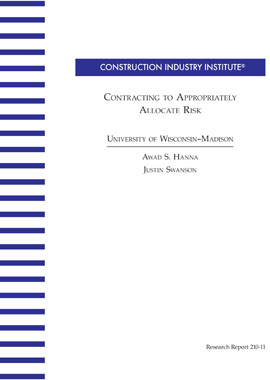
Contracting to Appropriately Allocate Risk
Many industry participants allocate construction risks, unfortunately, by the process of aversion. Owners have a tendency to shift risk to the primary contractor, who in turn pushes risk to the lower-tier parties in the contracting arrangement. As a consequence, parties with the least amount of control and influence over many of the risk-producing factors and decisions often carry the majority of the construction risk burden.
Another well-known scenario in the allocation process is the battle between two strongwilled individuals. In some cases, the owner may have the upper hand in hammering out the negotiations, but the contractor may be the only available resource to do the job and will wield power in a similar fashion. Both parties, in essence, try to shove as much risk as possible to the other party when they possess the bargaining power to do so.
The construction industry, despite extensive research into risk allocation, has yet to accept a conclusive and widely accepted practice. The current perception is that prevailing risk allocation strategies are ineffective and detrimental to overall project performance and success. The developed research conducted by the Construction Industry Institute (CII) Contracting to Appropriately Allocate Risk Research Team and discussed in the following pages, however, encourages risk allocation in a compromising and educated manner, recognizing the unique circumstances of each specific project.
Several major research conclusions were made during the investigation. First, the industry has much to learn concerning appropriate risk allocation. Secondly, it is neither appropriate nor logical to specify that a particular risk should be allocated a certain way for any and every project. Also, inappropriate risk allocation may lead to increased costs for both owners and contractors. Lastly, both the owner and the contractor should be involved in the risk allocation process, which should begin early in the project life cycle.
Based on these conclusions, the research team developed the “Two-Party Risk Assessment and Allocation Model” that encourages contracting parties to compromise during the risk allocation process since continually shifting risk to lower-tier parties can result in financial impacts for all contracting parties. The model is designed to identify, assess, and allocate risk before project execution so that risk management efforts during project performance are minimized.
The research and the model are described in the following pages. Industry participants are encouraged to seek out the model as it facilitates involvement from any two contracting parties early in the life cycle of a project and helps in the goal of appropriately allocating each particular risk to the party that is best equipped to handle the risk for a particular project. Although the research team focused on design-bid-build, lump sum work under an owner-contractor contract, many aspects of the model apply to numerous other delivery systems and contracting parties.

